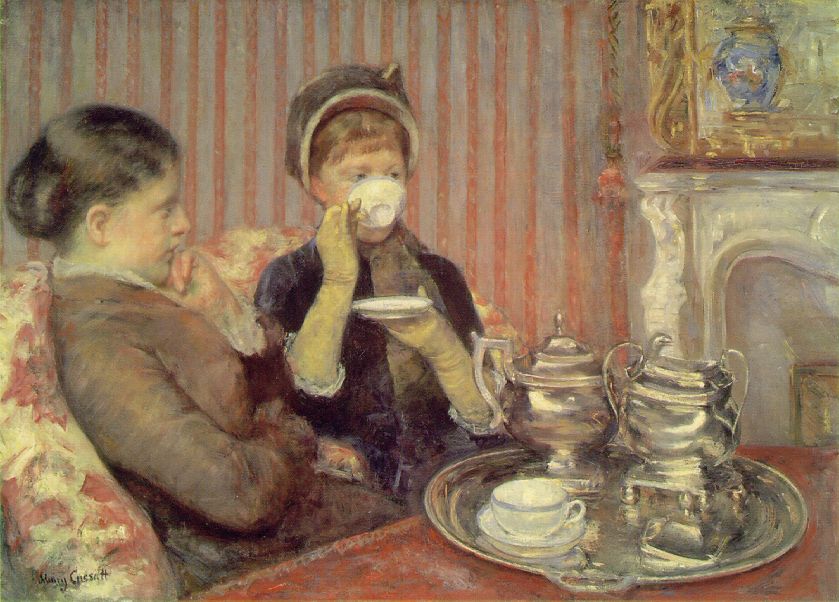 There's a stereotype that the British are obsessed with tea -- every afternoon, they supposedly sit down and have tea, delicately extending their pinky finger as they drink and exchanging snobby, proper conversation.
There's a stereotype that the British are obsessed with tea -- every afternoon, they supposedly sit down and have tea, delicately extending their pinky finger as they drink and exchanging snobby, proper conversation.I highly doubt that's true -- I'll bet my own pinky finger that they're nowhere near as obsessed with tea as Russians are. Though one could hardly say that the Russian tea time is snobby and proper -- you'd have to search hard to find any proper Russian people, period. Personally, I like to flash or cuss at a stranger at least once a week. And without tea, I just wouldn't have the strength to fulfill my quota.
The Russian tea time is wonderfully ambiguous -- it may happen at noon, or at 3 (PM or AM-- pick your choice), or right after dinner. The table is set with any snacks around -- jam, chocolates, candy, cheese sandwiches, even salami. The water is heated and zavarka -- a very strong tea -- is brewed in the teapot. If it is too strong for your tastes, you are supposed to add in some more hot water to your cup -- or discreetly pour it onto your host's shoes, if you're so inclined. When the tea is too hot, many Russians will pour it into the saucer and sip it from there, usually with a fairly loud slurping noise -- if you want to avoid a burnt mouth, it would be wise to follow their example.
I should mention that Russia is currently in the throes of a nationwide, heated debate over whether one should drink loose leaf tea or tea from teabags. Some say that teabags make bland tea, as the tea leaves are mercilessly chopped and dried until they turn into a stale powder more suited to go up one's nose, and suggest that teabag-users move to the U.S. if they're so into convenience. The other side responds with, "YOU'RE unethical! We'll chop YOU to a powder!" Sadly, I suspect that much like the Lilliputs of "Gulliver's Travels," Russia will soon split into two nations -- one with teapots, and one with teabags.
The most popular tea in Russia is probably Assam -- a strong black tea grown in Assam, India (hence the name). It's usually sold in tins or boxes with "Indian" things on them -- you know, shahs riding around on elephants, belly dancing girls, belly dancing girls conversing with shahs, etc. One would think there are no people there other than shahs and belly dancers. Green and herbal teas have also become popular, as of late, particularly herbal teas claiming to be cleansing and weight-loss promoting. Of course, people in Russia have been gathering and drinking Willowherb tea for some centuries, but unfortunately Willowherb doesn't sort itself into convenient packages with the words "Ancient Wisdom Shaman Gypsy Herbal Cleansing Tea," and as such is no longer as popular as it used to be.
Since tea was first introduced to Russia in the 1600's, ways of drinking it have changed a great deal, mainly based on the availability of sugar. Originally, many people drank plain black tea (imported from China at the time), taking bites out of a sugar beet after each sip. Later, it became common to drink tea with sugar "on the side" -- that usually referred to either keeping a sugar cube in your mouth as you drank the tea, or biting pieces off it after each sip. When sugar became cheaper and easier to get, people started putting it in the tea by the teaspoon or cube, but tea itself became harder to get right before and after the splitting of the USSR. Fortunately, the situation improved, but even now it's still quite common to find horrid-tasting teas on the store shelves.
Tea time is a perfect time to relax, enjoy yourself, and talk about the depth of the Russian soul and the suffering it experiences. I strongly suggest you (dear reader) buy a tea set and start having regular tea time, Russian-style. A teapot is a must, as well as someone to drink tea with, jam, and chocolate -- sugar cubes are preferable, but not necessary. An even better suggestion would be to buy a nice samovar and use it regularly -- particularly if you live out in the country (like a dacha) and have too much firewood. But dachas and samovars are topics I will save for future posts.
No comments:
Post a Comment